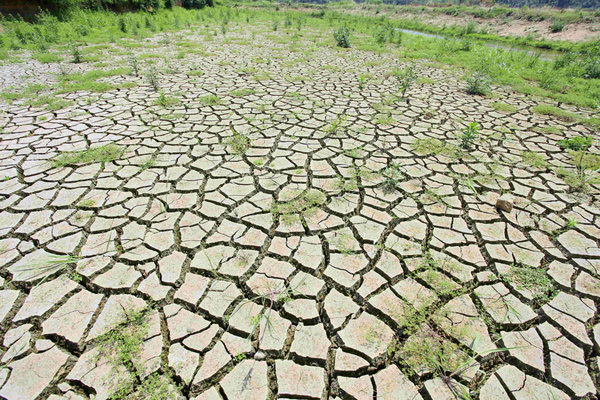Society
Yangtze drought affects 5% of China's farmland
(Xinhua)
Updated: 2011-05-30 21:42
 |
Large Medium Small |
|
 Dry and cracked farmland is seen in this picture taken on May 30, 2011 in Hukou County of East China's Jiangxi Province. [Photo/CFP]
|
BEIJING - Droughts have negatively impacted 104.4 million mu (6.96 million hectares), or more than 5 percent, of China's farmlands as of Sunday, the country's top drought relief authority said.
A lingering drought has affected 3.29 million people and 950,000 livestock in the provinces of Jiangsu, Anhui, Jiangxi, Hubei, and Hunan, according to the latest statistics from the Office of State Flood Control and Drought Relief Headquarters (SFDH).
|
||||
Rainfall along the lower and middle reaches of the Yangtze has been at its lowest since 1951, down 40 to 60 percent from the average level, the SFDH said.
A lack of rain has also led to lower water levels in nearby lakes and rivers, according to the SFDH.
At 8 am Sunday, water levels at Xingzi Station, a water monitoring station in Poyang Lake in Jiangxi Province, were recorded at 10.79 meters, down 4.64 meters from the area's average level. Poyang is China's largest freshwater lake.
At the same time, workers at Chenglingji Station, which is located on Dongting Lake in neighboring Hunan Province, recorded water levels of 23.71 meters, 2.82 meters lower than the area's average level.
In Hubei Province, fishermen living by Hong Lake are unable to fish there anymore, as the drought has almost completely dried up the 413-square-kilometer lake.
Figures from the lake's drought relief authority showed that the lake's total rainfall for this year measured just 100 millimeters.
The drought has also hampered early- and middle-season rice planting, the SFDH said.
However, summer wheat harvests will not be greatly affected, as the country's major wheat belt has been unaffected by the drought, the SFDH said.
To help relieve the effects of the drought, the SFDH, together with the Ministry of Water Resources, recently arranged for the Three Gorges Dam, the world's largest hydropower station, to discharge more water to downstream areas as the drought continues.
According to the SFDH, the dam has been discharging water at a rate of 11,000 to 12,000 cubic meters per second since May 25 and will continue to do so until June 10. The previous water discharge rate was 10,000 cubic meters per second.
The dam was discharging water at a rate of 11,500 cubic meters per second at 8 am Sunday, reducing the dam reservoir's water level to 150.87 meters, according to the SFDH.
The Three Gorges Dam has discharged 2.8 billion cubic meters of water since May this year, said Zhang.
Currently, the dam is discharging about 200 million cubic meters of water each day, which has helped to raise downstream water levels by 1.39 to 2.72 meters, according to Zhang.
A total of 1.96 billion yuan ($302.4 million) of China's central budget has been allocated to drought relief work so far, the SFDH said.
The SFDH has also warned of the possibility of large floods following the drought, urging local authorities to ensure that dikes and reservoirs are in good condition ahead of the rainy season.
Economists are worried that the drought could push up the prices of food and raw materials, creating inflationary pressures. Controlling inflation is one of the Chinese government's top priorities this year.
Leafy vegetables such as cabbage, rape and romaine lettuce saw price hikes in mid-May, according to data from the Ministry of Commerce.
Cabbage prices soared by 23 percent, rape went up 19.8 percent and romaine lettuce surged 16.7 percent, the ministry said.
| 分享按钮 |

